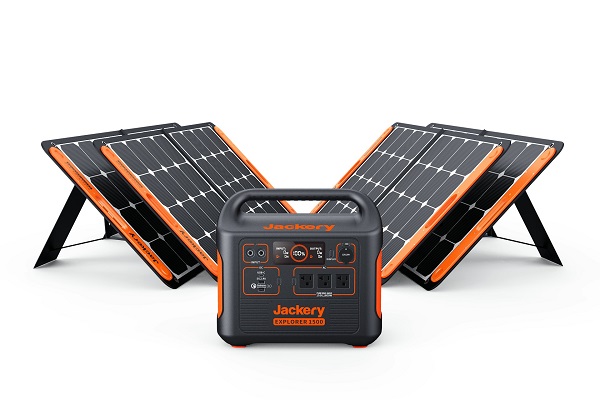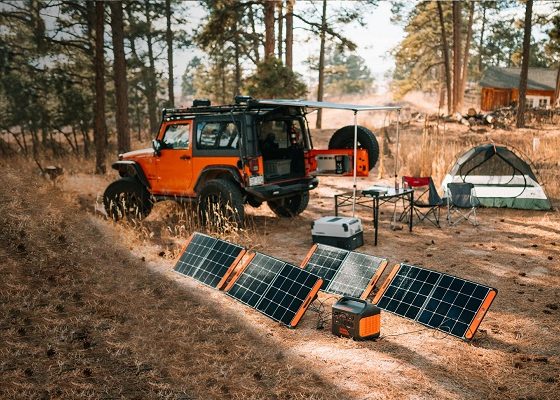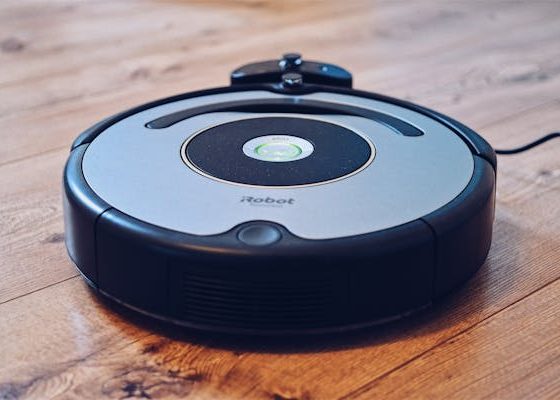In today’s world, energy demands have surged with the increasing dependence on gadgets, appliances, and electronic devices. Whether you’re camping in the wilderness, dealing with a power outage, or just need backup power, a portable power station can be your lifesaver. The best portable power station is a highly convenient, eco-friendly, and versatile power source, perfect for charging devices, running small appliances, and even powering sensitive electronics like laptops and smartphones.

This article will delve into everything you need to know about the best portable power station, from why you need one to the top options available on the market. We will also cover key factors to consider when choosing a portable power station, and finally, provide some real-world scenarios where these devices are indispensable.
What is a Portable Power Station?
A portable power station is essentially a large rechargeable battery with an inverter, enabling it to convert stored energy into AC (alternating current) or DC (direct current) power. These devices provide power on the go and can charge small to large devices, from smartphones and laptops to refrigerators and power tools. They come with multiple outlets, such as USB ports, AC sockets, and DC outputs, giving you the flexibility to charge different devices simultaneously.
Unlike traditional gas-powered generators, portable power stations run on clean energy—either charged via an AC wall outlet, solar panels, or a car’s 12V socket. They offer quiet, emission-free operation, making them a popular choice for eco-conscious users and adventurers alike.
Why Choose a Portable Power Station?
When faced with a power outage, extended camping trips, or the need for reliable backup power, the best portable power station offers a unique set of advantages over traditional generators and other power solutions. Here are the key reasons why more and more people are opting for portable power stations:
- Eco-Friendly: Unlike gas-powered generators, portable power stations don’t produce harmful emissions, making them environmentally friendly. They often come with solar charging options, allowing you to harness renewable energy.
- Quiet Operation: Portable power stations run silently compared to the loud engines of traditional generators, making them ideal for use in noise-sensitive environments like campsites or RV parks.
- Versatility: Whether you need to power a laptop, refrigerator, or medical equipment, the best portable power station has multiple output options to handle a wide range of devices.
- Ease of Use: These stations are extremely user-friendly. Most feature plug-and-play capabilities, allowing you to connect devices quickly without complex setups.
- Portability: As the name suggests, portable power stations are compact and designed to be carried easily, making them ideal for outdoor adventures or emergency backup in areas with frequent power outages.
Key Features to Look for in the Best Portable Power Station
Before purchasing a portable power station, it’s essential to consider several factors to ensure it meets your needs. Here’s a list of features to keep in mind when selecting the best portable power station:
- Battery Capacity (Watt-Hours): The capacity of a portable power station is measured in watt-hours (Wh). The higher the watt-hour rating, the more power it can store. For example, a station with a capacity of 1000Wh can power a 100W device for 10 hours.
- Power Output (Watts): The power output determines what devices a portable power station can handle. If you plan to power energy-hungry appliances, like a refrigerator or microwave, look for a model with at least 1000W of continuous output.
- Input Options: The best portable power station should support multiple recharging methods, including solar panels, wall outlets, and car chargers. This ensures you can keep it charged no matter where you are.
- Port Types: Most portable power stations come with a mix of AC outlets, USB ports, and 12V DC outputs. Consider your power needs and ensure the station has enough ports to charge all your devices simultaneously.
- Weight and Portability: While capacity and output are important, don’t overlook the unit’s weight. A high-capacity power station is great, but if it’s too heavy to carry around, it loses its portability advantage.
- Charging Speed: Look for models that offer fast recharging capabilities. Some can fully charge in as little as two hours when plugged into a wall outlet.
- Durability: If you plan to use your portable power station in rugged environments like camping or outdoor work sites, ensure it’s built with durable, weather-resistant materials.
Top 5 Best Portable Power Stations on the Market
Let’s explore some of the top portable power stations available, taking into account their performance, features, and customer satisfaction.
a. EcoFlow Delta 1300
The EcoFlow Delta 1300 is one of the most powerful portable power stations on the market. With a massive 1260Wh battery and a 1800W inverter, this unit can power everything from laptops and smartphones to small appliances and power tools. It features 6 AC outlets, 4 USB-A ports, and 2 USB-C ports, ensuring that all your devices are covered.
One of its standout features is the incredibly fast charging time—it can charge from 0 to 80% in just one hour when plugged into an AC wall outlet. Moreover, it supports solar panel charging, making it a favorite among campers and adventurers who want to stay off the grid.
b. Jackery Explorer 1000
The Jackery Explorer 1000 is often regarded as one of the best portable power stations for campers and RV enthusiasts. With 1002Wh capacity and a 1000W inverter, it can power multiple devices simultaneously, including mini-fridges, TVs, and laptops. It offers 3 AC outlets, 2 USB-A ports, 2 USB-C ports, and a DC carport.
It’s also known for its lightweight design, weighing only 22 lbs, making it easy to carry around. With its high efficiency and reliable performance, the Jackery Explorer 1000 is an excellent choice for those looking for a powerful yet compact power solution.
c. Goal Zero Yeti 1500X
If you’re seeking high capacity, the Goal Zero Yeti 1500X offers 1516Wh of power, which is enough to run medium-sized appliances for extended periods. It comes equipped with a 2000W AC inverter, meaning it can handle heavy-duty devices such as power tools and even larger home appliances.
This station also shines when it comes to solar charging compatibility. With its integrated MPPT (Maximum Power Point Tracking) controller, it maximizes the efficiency of solar panel charging, making it a great option for sustainable energy solutions.
d. Bluetti AC200P
The Bluetti AC200P is a true workhorse with its 2000Wh battery capacity and 2000W inverter. It’s built for those who need a large amount of power, whether for emergency home backup or powering high-demand devices on the go. It offers a wide array of outputs, including 6 AC outlets, 1 12V carport, 4 USB-A ports, and a 60W USB-C port.
It also supports fast solar recharging, taking advantage of its large battery bank to provide long-lasting power without relying on traditional sources. The Bluetti AC200P is the best portable power station for anyone seeking massive capacity without compromising on portability.
e. Anker 757 PowerHouse
The Anker 757 PowerHouse is a well-rounded option with 1229Wh capacity and a 1500W inverter. Known for its durability and reliable performance, the Anker 757 PowerHouse offers a variety of charging options, including 6 AC outlets, 4 USB ports, and a car socket.
One of its best features is its long-lasting battery, which can support up to 3000 charge cycles. Anker’s reputation for building high-quality, durable products extends to this model, making it an excellent investment for anyone needing reliable power for years to come.
How to Choose the Best Portable Power Station for Your Needs
Now that you’re familiar with the top portable power stations, it’s important to determine which one best suits your specific needs. Here are some critical factors to consider:
- Usage: What do you plan to power? If you’re only charging small devices, a lower capacity station like the Jackery Explorer 500 may suffice. But if you need to power larger appliances or multiple devices, consider higher capacity options like the Goal Zero Yeti 1500X.
- Battery Capacity: Estimate your power consumption needs. A station with a 1000Wh battery can power a 10W LED light for 100 hours, but a 1000W microwave will only last an hour.
- Portability: If you plan to move your power station frequently, opt for a lighter, more portable model. For instance, the Jackery Explorer 1000 weighs only 22 lbs, making it highly portable, while the Bluetti AC200P is heavier but offers more power.
- Budget: Portable power stations range widely in price depending on capacity, features, and brand. Set a budget and determine the features most important to you before making a purchase.
- Charging Options: Do you want solar charging capabilities? If so, ensure the station supports solar panels and has an MPPT controller for optimal efficiency.
Portable Power Stations vs. Traditional Generators
While traditional gas-powered generators have been the go-to for backup power for decades, portable power stations offer several advantages. Here’s how they compare:
| Feature | Portable Power Station | Traditional Generator |
|---|---|---|
| Fuel Source | Battery (Rechargeable) | Gasoline/Diesel |
| Noise Level | Silent | Loud |
| Emissions | None (Eco-friendly) | Emits harmful gases |
| Portability | Lightweight and compact | Heavier and bulkier |
| Maintenance | Low (battery care) | Requires regular maintenance |
| Use Indoors | Safe for indoor use | Not safe for indoor use |
Real-World Uses for Portable Power Stations
The best portable power station has a wide range of applications, making it incredibly versatile. Here are some real-world scenarios where a portable power station can be invaluable:
- Camping and RV Trips: Keep your lights, fans, and portable fridge running while you’re off-grid.
- Emergency Power Backup: During power outages, a portable power station can keep essential devices like medical equipment, phones, and refrigerators operational.
- Outdoor Events: If you’re hosting an event outdoors, a portable power station can provide reliable power for sound systems, lights, and more.
- Job Sites: Power tools and equipment at remote job sites where traditional power sources aren’t available.
- Van Life: Many people living the #VanLife use portable power stations to power their appliances, ensuring comfort while on the road.
Maintenance and Safety Tips for Portable Power Stations
To ensure your portable power station remains in optimal working condition, follow these maintenance and safety tips:
- Regular Charging: Even if you’re not using the power station, charge it every three to six months to prevent the battery from draining completely.
- Keep It Clean: Wipe down the unit regularly to avoid dust and dirt buildup, especially around the ports.
- Store Properly: Keep the power station in a cool, dry place away from direct sunlight or extreme temperatures.
- Don’t Overload: Avoid plugging in devices that exceed the power station’s maximum output to prevent overloading the inverter.
- Use the Right Cables: Always use the provided cables or recommended cables for charging and discharging devices.
Conclusion
The best portable power station for you depends on your power needs, budget, and intended use. Whether you’re camping, preparing for an emergency, or need power on the go, there’s a portable power station to suit your needs. With eco-friendly operation, silent functionality, and easy portability, these power stations provide a modern solution to age-old power challenges.
From the powerful EcoFlow Delta 1300 to the budget-friendly Jackery Explorer 1000, each model has its own strengths. Evaluate your specific needs, and make an informed decision to ensure you choose the best portable power station for your situation.














